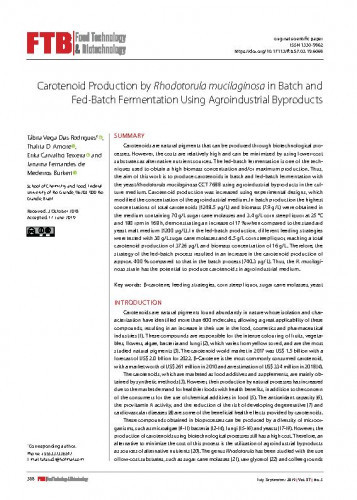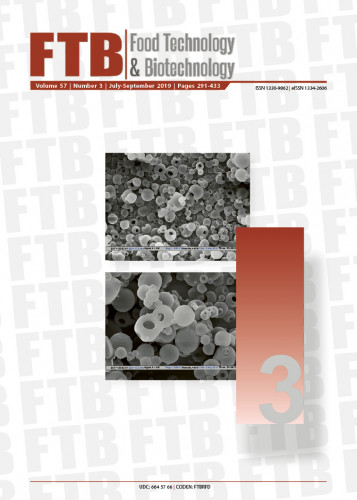Carotenoids are natural pigments that can be produced through biotechnological processes. However, the costs are relatively high and can be minimized by using lower-cost substrates as alternative nutrient sources. The fed-batch fermentation is one of the techniques used to obtain a high biomass concentration and/or maximum production. Thus, the aim of this work is to produce carotenoids in batch and fed-batch fermentation with the yeast Rhodotorula mucilaginosa CCT 7688 using agroindustrial byproducts in the culture medium. Carotenoid production was increased using experimental designs, which modified the concentration of the agroindustrial medium. In batch production the highest concentrations of total carotenoids (1248.5 μg/L) and biomass (7.9 g/L) were obtained in the medium containing 70 g/L sugar cane molasses and 3.4 g/L corn steep liquor at 25 °C and 180 rpm in 168 h, demonstrating an increase of 17 % when compared to the standard yeast malt medium (1200 μg/L). In the fed-batch production, different feeding strategies were tested with 30 g/L sugar cane molasses and 6.5 g/L corn steep liquor, reaching a total carotenoid production of 3726 μg/L and biomass concentration of 16 g/L. Therefore, the strategy of the fed-batch process resulted in an increase in the carotenoid production of approx. 400 % compared to that in the batch process (740.3 μg/L). Thus, the R. mucilaginosa strain has the potential to produce carotenoids in agroindustrial medium.; Karotenoidi su prirodni pigmenti koji se mogu proizvesti pomoću biotehnoloških procesa. Međutim, troškovi su njihove proizvodnje relativno visoki, no mogu se smanjiti primjenom jeftinih alternativnih izvora hranjiva. Uzgojem s pritokom supstrata postižu se visoke koncentracije biomase i/ili najveći prinos. Stoga je svrha ovoga rada bila proizvesti karotenoide šaržnom fermentacijom i uzgojem s pritokom supstrata s pomoću kvasca Rhodotorula mucilaginosa CCT 7688 u podlozi s nusproizvodima agroindustrije. Proizvodnja je poboljšana primjenom eksperimentalnog dizajna, pomoću kojeg je optimirana koncentracija nusproizvoda agroindustrije u podlozi. Najveće koncentracije ukupnih karotenoida (1248,5 μg/L) i biomase (7,9 g/L) u šaržnom postupku dobivene su primjenom podloge od 70 g/L melase šećerne trske i 3,4 g/L kukuruznog ekstrakta pri 25 °C i 180 rpm tijekom 168 h, što je 17 % više nego u standardnoj podlozi s ekstraktima kvasca i slada (1200 μg/L). Tijekom uzgoja s pritokom supstrata ispitani su različiti načini prihranjivanja supstrata s 30 g/L melase šećerne trske i 6,5 g/L kukuruznog ekstrakta, te su postignute najveće koncentracije karotenoida od 3726 μg/L i biomase od 16 g/L. Uzgojem s pritokom supstrata dobiveno je otprilike 400 % više karotenoida, u usporedbi sa šaržnom fermentacijom (740,3 μg/L). Stoga je zaključeno da se kvasac R. mucilaginosa može upotrijebiti za proizvodnju karotenoida u podlozi od agroindustrijskog otpada.
Sažetak

 Food technology and biotechnology : journal of the Faculty of Food Technology and Biotechnology, University of Zagreb, Zagreb, Croatia : 57,3(2019) / editor-in-chief Vladimir Mrša.
Food technology and biotechnology : journal of the Faculty of Food Technology and Biotechnology, University of Zagreb, Zagreb, Croatia : 57,3(2019) / editor-in-chief Vladimir Mrša.